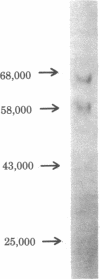Abstract
gamma-Aminobutyric acid (GABA) and benzodiazepine receptors have been solubilized and purified by procedures such as gel filtration, ion-exchange, lectin, and affinity chromatographies. All of these procedures enhance the specific activity of each receptor to a similar extent. The drug specificities of [3H]muscimol and [3H]flunitrazepam binding sites are the same after extensive purification by affinity chromatography compared to the membrane bound and initially solubilized receptors. GABA and chloride stimulation of benzodiazepine binding is retained in pure receptors. Two bands are covalently labeled with [3H]flunitrazepam after ultraviolet irradiation of the purified receptor. The persistent association of GABA, benzodiazepine, and chloride recognition sites after extensive purification suggests that they may be part of a single macromolecular complex.
Full text
PDF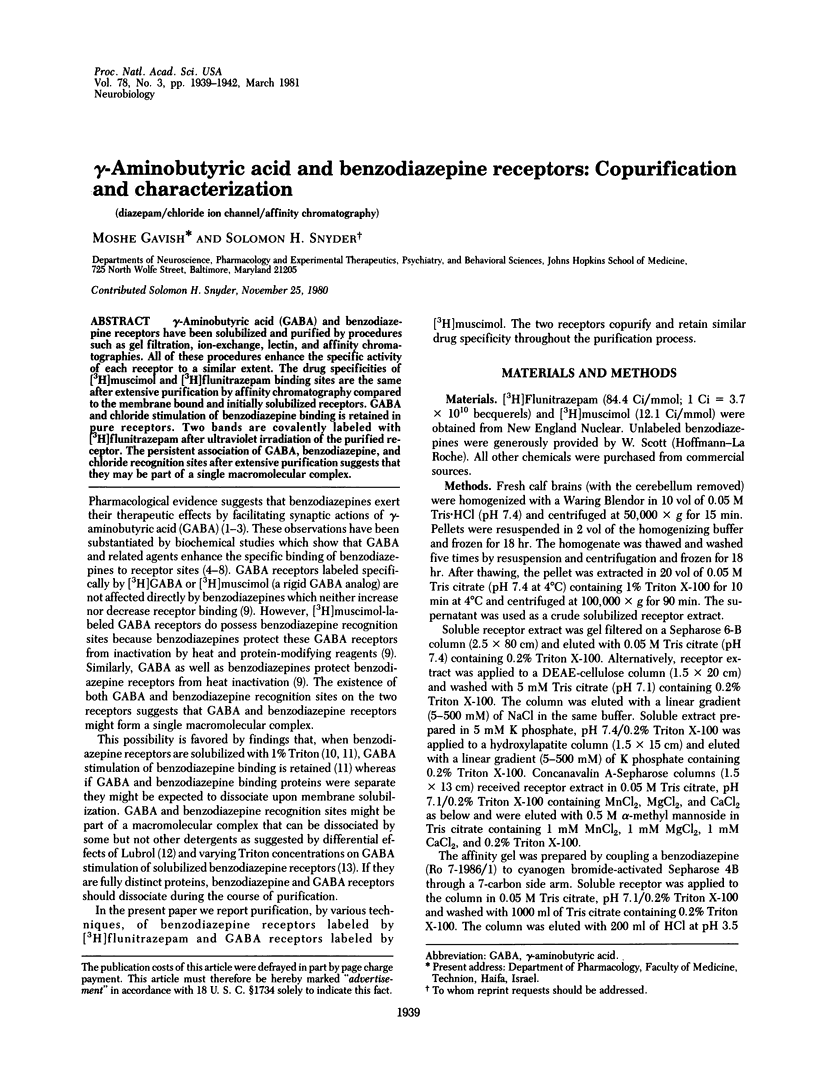
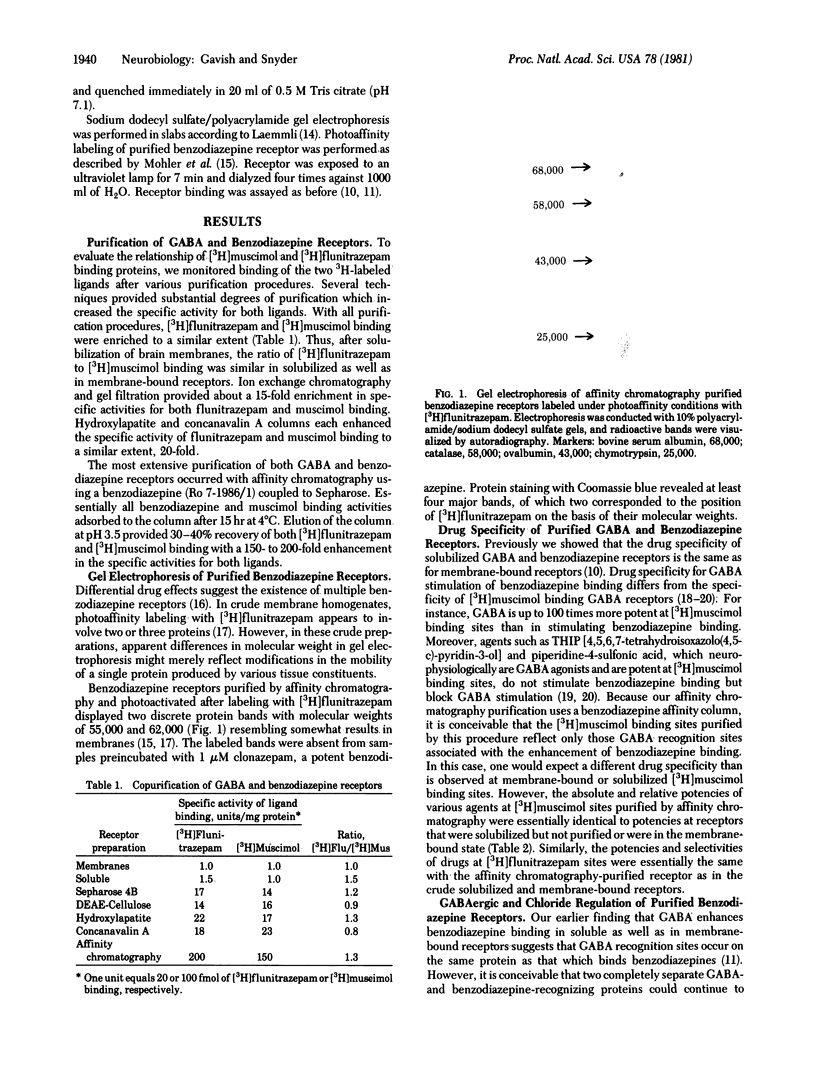
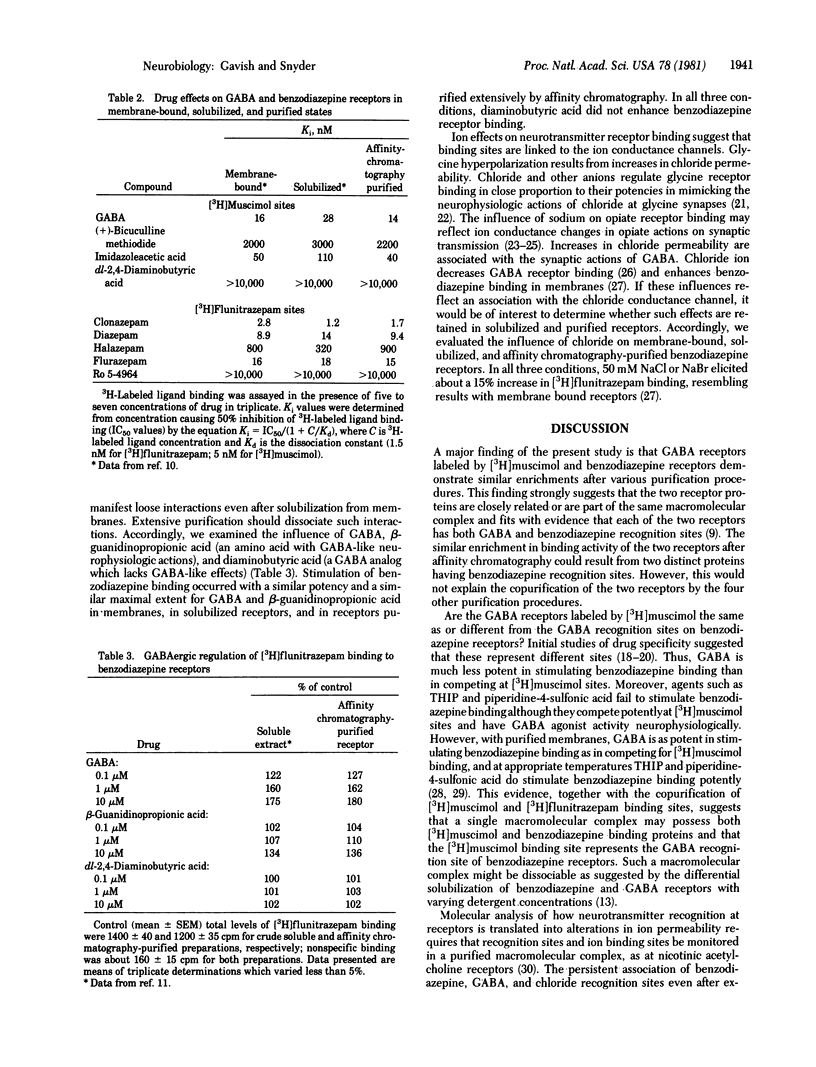
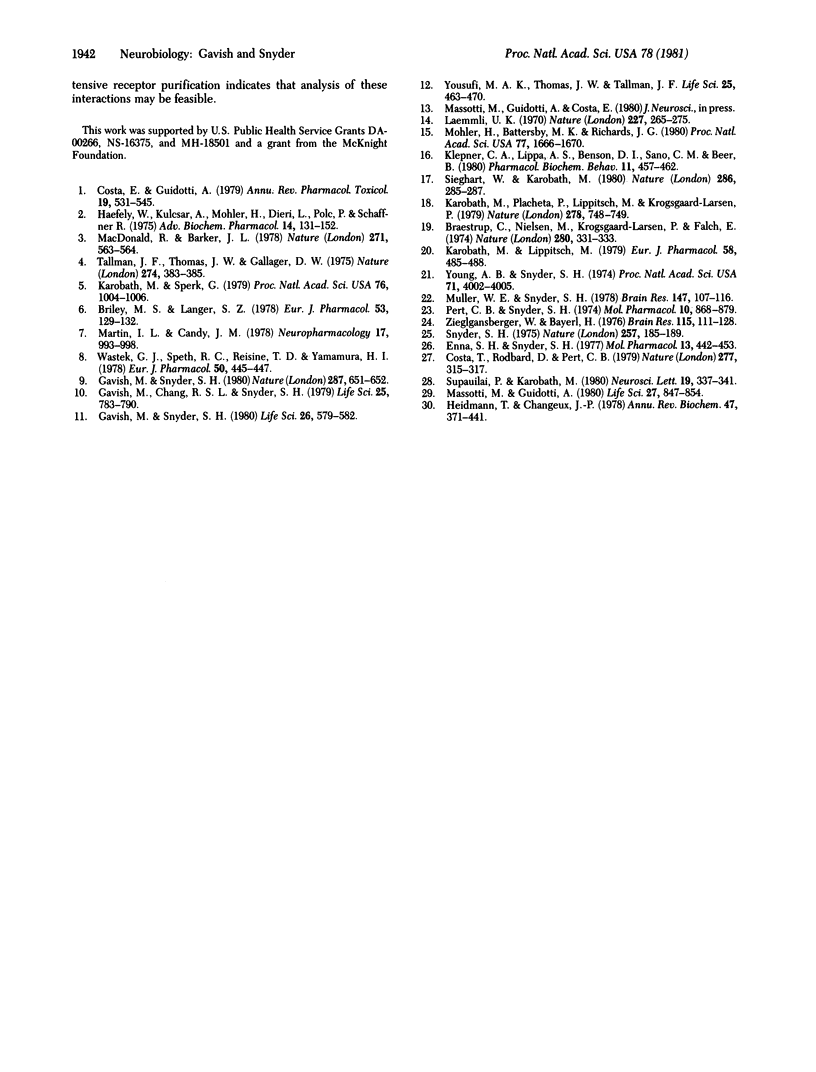
Images in this article
Selected References
These references are in PubMed. This may not be the complete list of references from this article.
- Braestrup C., Nielsen M., Krogsgaard-Larsen P., Falch E. Partial agonists for brain GABA/benzodiazepine receptor complex. Nature. 1979 Jul 26;280(5720):331–333. doi: 10.1038/280331a0. [DOI] [PubMed] [Google Scholar]
- Briley M. S., Langer S. Z. Influence of GABA receptor agonists and antagonists on the binding of 3H-diazepam to the benzodiazepine receptor. Eur J Pharmacol. 1978 Nov 1;52(1):129–132. doi: 10.1016/0014-2999(78)90031-6. [DOI] [PubMed] [Google Scholar]
- Costa E., Guidotti A. Molecular mechanisms in the receptor action of benzodiazepines. Annu Rev Pharmacol Toxicol. 1979;19:531–545. doi: 10.1146/annurev.pa.19.040179.002531. [DOI] [PubMed] [Google Scholar]
- Costa T., Rodbard D., Pert C. B. Is the benzodiazepine receptor coupled to a chloride anion channel? Nature. 1979 Jan 25;277(5694):315–317. doi: 10.1038/277315a0. [DOI] [PubMed] [Google Scholar]
- Enna S. J., Snyder S. H. Influences ions, enzymes, and detergents on gamma-aminobutyric acid-receptor binding in synaptic membranes of rat brain. Mol Pharmacol. 1977 May;13(3):442–453. [PubMed] [Google Scholar]
- Gavish M., Chang R. S., Snyder S. H. Solubilization of histamine H-1, GABA and benzodiazepine receptors. Life Sci. 1979 Aug 27;25(9):783–789. doi: 10.1016/0024-3205(79)90523-x. [DOI] [PubMed] [Google Scholar]
- Gavish M., Snyder S. H. Benzodiazepine recognition sites on GABA receptors. Nature. 1980 Oct 16;287(5783):651–652. doi: 10.1038/287651a0. [DOI] [PubMed] [Google Scholar]
- Gavish M., Snyder S. H. Soluble benzodiazepine receptors: GABAergic regulation. Life Sci. 1980 Feb 25;26(8):579–582. doi: 10.1016/0024-3205(80)90231-3. [DOI] [PubMed] [Google Scholar]
- Haefely W., Kulcsár A., Möhler H., Pieri L., Polc P., Schaffner R. Possible involvement of GABA in the central actions of benzodiazepines. Adv Biochem Psychopharmacol. 1975;(14):131–151. [PubMed] [Google Scholar]
- Karobath M., Lippitsch M. THIP and isoguvacine are partial agonists of GABA-stimulated benzodiazepine receptor binding. Eur J Pharmacol. 1979 Oct 15;58(4):485–488. doi: 10.1016/0014-2999(79)90321-2. [DOI] [PubMed] [Google Scholar]
- Karobath M., Placheta P., Lippitsch M., Krogsgaard-Larsen P. Is stimulation of benzodiazepine receptor binding mediated by a novel GABA receptor? Nature. 1979 Apr 19;278(5706):748–749. doi: 10.1038/278748a0. [DOI] [PubMed] [Google Scholar]
- Karobath M., Sperk G. Stimulation of benzodiazepine receptor binding by gamma-aminobutyric acid. Proc Natl Acad Sci U S A. 1979 Feb;76(2):1004–1006. doi: 10.1073/pnas.76.2.1004. [DOI] [PMC free article] [PubMed] [Google Scholar]
- Klepner C. A., Lippa A. S., Benson D. I., Sano M. C., Beer B. Resolution of two biochemically and pharmacologically distinct benzodiazepine receptors. Pharmacol Biochem Behav. 1979 Oct;11(4):457–462. doi: 10.1016/0091-3057(79)90125-4. [DOI] [PubMed] [Google Scholar]
- Macdonald R., Barker J. L. Benzodiazepines specifically modulate GABA-mediated postsynaptic inhibition in cultured mammalian neurones. Nature. 1978 Feb 9;271(5645):563–564. doi: 10.1038/271563a0. [DOI] [PubMed] [Google Scholar]
- Martin I. L., Candy J. M. Facilitation of benzodiazepine binding by sodium chloride and GABA. Neuropharmacology. 1978 Nov;17(11):993–998. doi: 10.1016/0028-3908(78)90145-4. [DOI] [PubMed] [Google Scholar]
- Massotti M., Guidotti A. Endogenous regulators of benzodiazepine recognition sites. Life Sci. 1980 Sep 8;27(10):847–854. doi: 10.1016/0024-3205(80)90079-x. [DOI] [PubMed] [Google Scholar]
- Muller W. E., Snyder S. H. Strychinine binding associated with synaptic glycine receptors in rat spinal cord membranes: ionic influences. Brain Res. 1978 May 19;147(1):107–116. doi: 10.1016/0006-8993(78)90775-8. [DOI] [PubMed] [Google Scholar]
- Möhler H., Battersby M. K., Richards J. G. Benzodiazepine receptor protein identified and visualized in brain tissue by a photoaffinity label. Proc Natl Acad Sci U S A. 1980 Mar;77(3):1666–1670. doi: 10.1073/pnas.77.3.1666. [DOI] [PMC free article] [PubMed] [Google Scholar]
- Sieghart W., Karobath M. Molecular heterogeneity of benzodiazepine receptors. Nature. 1980 Jul 17;286(5770):285–287. doi: 10.1038/286285a0. [DOI] [PubMed] [Google Scholar]
- Supavilai P., Karobath M. The effect of temperature and chloride ions on the stimulation of [3H]flunitrazepam binding by the muscimol analogues THIP and piperidine-4-sulfonic acid. Neurosci Lett. 1980 Oct 2;19(3):337–341. doi: 10.1016/0304-3940(80)90284-0. [DOI] [PubMed] [Google Scholar]
- Tallman J. F., Thomas J. W., Gallager D. W. GABAergic modulation of benzodiazepine binding site sensitivity. Nature. 1978 Jul 27;274(5669):383–385. doi: 10.1038/274383a0. [DOI] [PubMed] [Google Scholar]
- Wastek G. J., Speth R. C., Reisine T. D., Yamamura H. I. The effect of gamma-aminobutyric acid on 3H-flunitrazepam binding in rat brain. Eur J Pharmacol. 1978 Aug 15;50(4):445–447. doi: 10.1016/0014-2999(78)90152-8. [DOI] [PubMed] [Google Scholar]
- Wickramasinghe N. C. Galactic component of the diffuse X-ray background. Nature. 1970 Jul 18;227(5255):265–266. doi: 10.1038/227265a0. [DOI] [PubMed] [Google Scholar]
- Young A. B., Snyder S. H. The glycine synaptic receptor: evidence that strychnine binding is associated with the ionic conductance mechanism. Proc Natl Acad Sci U S A. 1974 Oct;71(10):4002–4005. doi: 10.1073/pnas.71.10.4002. [DOI] [PMC free article] [PubMed] [Google Scholar]
- Zieglgänsberger W., Bayerl H. The mechanism of inhibition of neuronal activity by opiates in the spinal cord of cat. Brain Res. 1976 Oct 8;115(1):111–128. doi: 10.1016/0006-8993(76)90826-x. [DOI] [PubMed] [Google Scholar]



